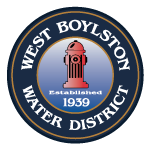Backflow is an unwanted flow of water in a reverse direction. When this happens our drinking water could be tainted by foul water, chemicals or other contaminants.
As your drinking water supplier, we are concerned about the possible introduction of contaminants to the drinking water from the sources we supply water to. Most outside contamination takes place when the customer uses equipment that re-pressurizes the water supplied, or when negative pressures occur in the water supply mains, as with a water main that breaks.
Typically, most water suppliers have a backflow prevention program in place that addresses this problem with commercial and industrial customers. These customers use their water supply for many purposes with a potential for cross contamination, the District closely monitors these services and often requires special testable devices be placed in their water supply piping to prevent contamination.
But, this concern doesn’t end with commercial and industrial customers. Residential customers must concern themselves with potential contamination, too.
Permanent irrigation systems require the installation of a backflow prevention device. Lawns are typically treated with composted materials and/or chemical fertilizers. In the event of a flow reversal, water exposed to the aforementioned contaminants could be introduced to the household and possibly the water distribution system.
Another potential source of contamination is the newer aspirator devices that are sold to apply insecticides and fertilizers. These devices connect to a hose and the velocity of the water draws the concentrated chemical up to a mixing area that becomes a spray. Most of these units are supplied with a check valve. However, these devices are easily fouled and can easily result in failure. Vacuum breakers are the best protection in this situation. These devices are available at the Water District office or they can also be purchased at most hardware stores and are generally built in on the new outside faucets.Never leave these devices connected to your water supply or unattended.[/vc_column_text][/vc_column][/vc_row]
